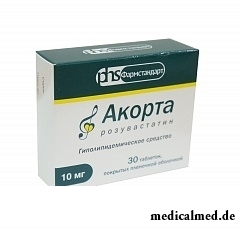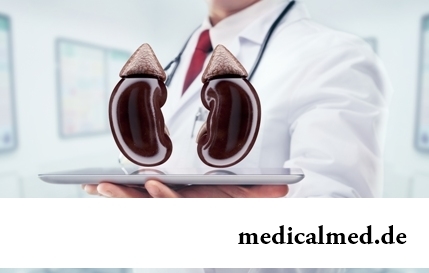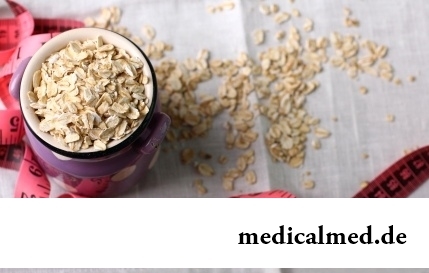





Akorta
Application instruction:
 Akorta – the medicine having hypolipidemic effect.
Akorta – the medicine having hypolipidemic effect.
Form of release and structure
Akorta is let out in the form of tablets, film coated: from pink till light pink color, round, biconvex; on a break – from cream till white color (on 10 pieces in blister strip packagings, in a cardboard pack 1-3 packagings).
Structure of 1 tablet:
- Active ingredient: розувастатин – 10 or 20 mg (розувастатин calcium – 10,4 or 20,8 mg);
- Auxiliary components (10/20 mg respectively): monohydrate of lactose (milk sugar) – 89,5/179 mg; microcrystallic cellulose – 29,82/59,64 mg; calcium hydrophosphate (E341) – 10,9/21,8 mg; кросповидон – 7,5/15 mg; magnesium stearate – 1,88/3,76 mg;
- Cover (10/20 mg respectively): Opadry II 30K240001 pink (monohydrate of lactose (milk sugar) – 2,4/4,8 mg; a gidroksipropilmetiltsellyuloz (gipromelloz) – 1,68/3,36 mg; titanium dioxide – 1,413/2,826 mg; triacetin (glyceryl triacetate) – 0,48/0,96 mg; dye red iron oxide – 0,027/0,054 mg) – 6/12 mg.
Indications to use
- Atherosclerosis (for the purpose of progressing delay) – as an additional tool to a diet at patients to whom therapy for reduction of concentration of the general cholesterol (XC) and cholesterol of lipoproteins of the low density (HS-LPNP) is shown;
- The main cardiovascular complications (primary prevention of a heart attack, stroke, arterial revascularization) at adult patients without clinical signs of coronary heart disease, but with the increased risk of its development (age at men – of 50 years, at women – of 60 years, the increased concentration of S-reactive protein (≥2 mg/l) with, at least, one of risk factors – arterial hypertension, low concentration of HS-LPVP, instructions in the family anamnesis of the early beginning of coronary heart disease);
- Family homozygous hypercholesterolemia – as an additional tool to a diet and other lipidosnizhayushchy therapy (for example, LPNP-aferez) or in cases if this therapy is insufficiently effective;
- Gipertriglitseridemiya (type IV across Fredrikson) – as an additional tool to a diet;
- The mixed hypercholesterolemia (lIb type) or primary hypercholesterolemia across Fredrikson (the IIa type, including a family heterozygous hypercholesterolemia) – as an additional tool to a diet in cases if the diet in combination with other non-drug methods of therapy (for example, weight reduction, physical exercises) is insufficiently effective.
Contraindications
Daily dose of 10 and 20 mg
Absolute:
- Predisposition to development of miotoksichesky complications;
- Myopathy;
- Renal failures of heavy degree (at clearance of creatinine less than 30 ml/min.);
- Liver disease in an active phase, including permanent increase in activity of hepatic transaminases, and also any increase in their activity in blood serum exceeding the upper bound of norm it is more, than by 3 times;
- Lactose intolerance, deficit of lactase or glyukozo-galaktozny malabsorption (lactose is Akorta's part);
- The combined use with cyclosporine;
- Use for women at reproductive age who do not use reliable contraceptive methods;
- Pregnancy and period of a lactation;
- Age up to 18 years (the profile of safety is not studied);
- Hypersensitivity to drug components.
Relative (Akort is appointed with care with risk of development of a myopathy / рабдомиолиза – the following diseases / states):
- Renal failure;
- Liver diseases in the anamnesis;
- Injuries;
- Hereditary muscular diseases in the anamnesis (personal or family) and the previous anamnesis of muscular toxicity at use of fibrat or other inhibitors of GMG-KOA-reduktazy;
- States at which the increased plasma concentration of a rozuvastatin is noted;
- Hypothyroidism;
- Extensive surgical interventions;
- Alcohol abuse;
- Sepsis;
- Arterial hypotension;
- Uncontrollable epilepsy;
- Metabolic, water and electrolytic or endocrine disturbances in a heavy current;
- The combined use from fibrata;
- Belonging to Mongoloid race;
- The age is more senior than 65 years.
Daily dose of 40 mg (in addition to above-mentioned contraindications)
Absolute:
- Muscular diseases in the anamnesis (personal or family);
- Renal failure of moderate severity (at clearance of creatinine less than 60 ml/min.);
- Alcohol abuse;
- Hypothyroidism;
- Miotoksichnost against the background of reception of other inhibitors of GMG-KOA-reduktazy or fibrat in the anamnesis;
- States at which the increased plasma concentration of a rozuvastatin is noted;
- The combined use from fibrata;
- Belonging to Mongoloid race.
Relative (Akort is appointed with care in the presence of the following diseases / states):
- Injuries;
- Liver diseases in the anamnesis;
- Renal failure of easy severity (at clearance of creatinine more than 60 ml/min.);
- Arterial hypotension;
- Sepsis;
- Extensive surgical interventions;
- Metabolic, water and electrolytic or endocrine disturbances in a heavy current or uncontrollable convulsive attacks;
- The age is more senior than 65 years.
Route of administration and dosage
Akort's pill is taken inside, regardless of meal, washing down with water. Time of day does not accord administration of drug on its efficiency of influence. It is not necessary to crush and chew tablets.
Before Akorta's appointment of the patient has to begin observance of a standard hypolipidemic diet which needs to adhere throughout all medical course.
The doctor selects a dose of a rozuvastatin individually. It is defined by the purpose of therapy and the therapeutic answer, and also has to correspond to the modern standard recommendations about target concentration of lipids.
If there are no other instructions of the doctor, to Akort accept in an initial dose 10 mg once a day. When determining a dose it is necessary to consider individual values of concentration of cholesterol, and also probability of development of cardiovascular complications and side reactions.
In a month if necessary increase in a dose is possible twice.
Further increase in a daily dose (to 40 mg) is shown to patients with a hypercholesterolemia in heavy degree and with high risk of cardiovascular complications (in particular the patient with a family hypercholesterolemia) at which the desirable result of therapy was not achieved at reception of lower doses. Such patients have to be under medical observation, also they should exercise control of indicators of function of kidneys.
It is not recommended to patients who did not see a doctor earlier to appoint Akorta in a dose of 40 mg.
In 2-4 weeks from the moment of the beginning of therapy, and also at increase in a dose it is necessary to carry out control of indicators of lipidic exchange. By its results carrying out selection of a dose can be shown.
Correction of the scheme of use of drug is not required to elderly patients.
Increase in system concentration of a rozuvastatin was noted among Chinese and Japanese that needs to be considered at purpose of therapy.
The heavy renal failure is a contraindication to Akorta's appointment in any doses, moderate – in a daily dose of 40 mg.
For patients, being carriers of genotypes s.521ss and s.421aa, the daily dose of Akorta should not be higher than 20 mg.
At patients with a liver failure (more than 9 points on a scale of Chayld-Pyyu) experience of use of drug is absent. A contraindication to performing therapy are liver diseases in an active phase.
It is not recommended to appoint the maximum daily dose of 40 mg in the presence of factors which can indicate existence at the patient of predisposition to development of a myopathy.
The risk of emergence of a myopathy (including рабдомиолиз) grows with increase in plasma concentration of a rozuvastatin, including because of the combined Akorta's use with such medicines as cyclosporine, some inhibitors of HIV proteases (including the combined use of a ritonavir with atazanaviry, tipranaviry and/or lopinaviry). If there is such opportunity, it is necessary to appoint alternative treatment. In need of simultaneous use of Akorta with these medicines it is necessary to correlate the expected advantage to possible risk.
Side effects
Scale of gradation of the registered side reactions: often (> 1/100, <1/10); infrequently (> 1/1000, <1/100); seldom (> 1/10000 <1/1000); very seldom (<1/10000); with an unknown frequency (at impossibility to estimate it according to the available data).
Side effects owing to therapy rozuvastatiny usually dozozavisima are also noted with the following frequency:
- Central and peripheral nervous system: often – dizziness, a headache, an asthenic syndrome; infrequently – neuralgia, uneasiness, paresthesias; very seldom – amnesia, polyneuropathy;
- Alimentary system: often – nausea, a lock, abdominal pains; seldom – pancreatitis, reversible passing dozozavisimy increase in activity of hepatic transaminases; very seldom – a gastroenteritis, dispepsichesky frustration (including diarrhea, a meteorism, vomiting), jaundice, hepatitis;
- Respiratory system: often – pharyngitis; infrequently – sinusitis, rhinitis, bronchial asthma, pneumonia, bronchitis; with an unknown frequency – cough, диспноэ;
- Cardiovascular system: infrequently – stenocardia, increase in arterial pressure, a heart consciousness, vazodilatation symptoms (including a dermahemia);
- Skeletal and muscular system: often – a mialgiya; infrequently – arthritis, a muscle hyper tone, dorsodynias, a pathological fracture of bones of extremities (without damages); seldom – a myopathy, рабдомиолиз (along with a renal failure, at reception in a dose of 40 mg); very seldom – an arthralgia; with an unknown frequency – the tendopatiya sometimes proceeding with complications in the form of gaps; the immunomediated necrotic myopathy;
- Urinary system: a proteinuria (as a rule, it decreases or disappears in the course of treatment; acute or progressing of the existing disease of kidneys it does not mean emergence); very seldom – a hamaturia;
- Allergic reactions: infrequently – a skin itch and rash, a small tortoiseshell; seldom – a Quincke's disease; with an unknown frequency – Stephens-Johnson's syndrome;
- Laboratory indicators: increase in plasma concentration of bilirubin, glucose, increase in activity of an alkaline phosphatase, gamma глутамилтранспептидазы; at insignificant number of patients – increase in activity of a kreatinfosfokinaza (dozozavisimy, insignificant, asymptomatic and temporary), in case of increase in indicators more than by 5 times in comparison with the upper bound of norm, to Akort is temporarily cancelled;
- Others: often – a diabetes mellitus 2 types; infrequently – pains in the area to a thorax, a grippopodobny syndrome, anemia, ecchymomas, periodontal abscess; seldom – thrombocytopenia; with an unknown frequency – a gynecomastia, peripheral hypostases.
Messages on development of the following disturbances at therapy some statines were: the sleep disorders including dreadful dreams and sleeplessness; depression; sexual dysfunction. It was reported about isolated cases of developing of an intersticial disease of lungs, in particular at long use of drugs.
Special instructions
Reception of high doses of Akorta, especially 40 mg, can lead to development of a proteinuria, preferential canalicular origin, but most often the disease has periodic or short-term character (development acute or progressing of the existing disease of kidneys does not mean it). During treatment at the patients accepting drug in a dose of 40 mg it is recommended to exercise control of indicators of function of kidneys.
It is not necessary to define activity of a kreatinfosfokinaza after the raised exercise stresses or in the presence of other probable causes of increase in its activity (incorrect interpretation of the received results is possible). If this indicator exceeds the upper bound of norm by 5 times, in 5-7 days it is necessary to take repeated measurement. If the repeated test confirms the previous indicator, it is not necessary to begin therapy.
With risk factors of a rabdomioliz it is necessary to estimate a ratio of advantage of therapy with probability of a disease and throughout all course of treatment to carry out clinical observation.
In cases of unexpected emergence of muscular weakness and pains or spasms, especially along with fever and an indisposition, it is necessary to consult with the specialist. Such patients need to carry out monitoring of level of activity of a kreatinfosfokinaza. Treatment is cancelled if activity of a kreatinfosfokinaza is increased more than by 5 times in comparison with the upper bound of norm, or in cases when muscular symptoms are sharply expressed and daily cause discomfort. After improvement of a state therapy can be resumed.
Very exceptional cases of development of the immunomediated necrotizing myopathy with clinical manifestations are celebrated (are shown as resistant weakness of proximal muscles and increase in activity of a kreatinfosfokinaza in blood serum). In these cases additional researches of nervous and muscular system, serological researches, and also performing therapy by immunodepressive means can be required.
Simultaneous use of Akorta with gemfibrozily is not recommended (because of high risk of development of a myopathy). It is not necessary to appoint treatment to patients with the acute, serious illnesses allowing to assume a myopathy or with possible development of a secondary renal failure (water and electrolytic disturbances, injuries, arterial hypertension, sepsis, surgical interventions, spasms, a metabolic syndrome, endocrine disturbances).
Care is demanded by Akorta's use for the patients abusing alcohol and in the presence of instructions in the anamnesis on liver diseases.
In 2-4 weeks from the moment of an initiation of treatment and/or at increase in a dose of Akorta it is necessary to control indicators of lipidic exchange (correction of the mode of dosing can be required).
It is recommended to carry out definition of activity of hepatic transaminases prior to therapy and 3 months later from the moment of an initiation of treatment. At exceeding of the upper bound of norm by 3 times reduce Akorta's dose or cancel therapy.
At patients with concentration of glucose of 5,6-6,9 mmol/l use of a rozuvastatin is associated with the increased risk of development of a diabetes mellitus 2 types.
Medicinal interaction
At the combined use of Akorta with some drugs / substances the following effects can be observed:
- Inhibitors of transport proteins: increase in plasma concentration of a rozuvastatin and risk of development of a myopathy;
- Cyclosporine, gemfibrozit: strengthening of effect of a rozuvastatin;
- Gemfibrozil, фенофибрат, and also other fibrata and lipidosnizhayushchy doses of niacin (more than 1 g a day): increase in risk of development of a myopathy (an admissible dose of Akorta in combination with gemfibrozily – 10 mg; reception of 40 mg of Akorta in a combination from fibrata is contraindicated);
- HIV protease inhibitors: significant increase in exposure of a rozuvastatin (the combination is not recommended);
- Antacids with the maintenance of ions of magnesium and aluminum: decrease in plasma concentration of a rozuvastatin (it is necessary to observe an interval not less than 2 hours between reception of these drugs);
- Erythromycin: decrease in effect of a rozuvastatin (because of strengthening of motility of digestive tract);
- Эзетимиб: increase in total concentration of Akorta at patients with a hypercholesterolemia, is not excluded development of the undesirable phenomena;
- Antagonists of vitamin K: increase in a prothrombin time;
- Oral contraceptives: strengthening of their effects.
Akorta's dose needs to be adjusted in need of the combined use with the following drugs (because of increase in exposure of a rozuvastatin): фенофибрат, cyclosporine, атазанавир, Silymarinum, лопинавир, gemfibrozit, элтромбопаг, дарунавир, ритонавир, типранавир, алеглитазар, фосампренавир, дронедарон, итроконазол, эзетимиб, Rifampinum, кетоконазол, флуконазол, erythromycin, байкалин. The maximum daily dose needs to be adjusted so that the expected exposure of a rozuvastatin was not higher that for the dose of 40 mg accepted as monotherapy.
Terms and storage conditions
To store in the place, unavailable to children, at a temperature up to 30 °C.
Period of validity – 2 years.
Name of drug
Price
Drugstore
Akorta тбл п/пл/о 10 mg No. 30, Pharmstandard-Tomskhimfarm of joint stock company
596 rub.
 Network of the Moscow drugstores of IFC
Network of the Moscow drugstores of IFCAkorta тбл п/пл/о 20 mg No. 30, Pharmstandard-Tomskhimfarm of joint stock company
824 rub.
 Network of the Moscow drugstores of IFC
Network of the Moscow drugstores of IFCThe well-known drug "Viagra" was initially developed for treatment of an arterial hypertension.

Aspirin (acetylsalicylic acid) – one of those drugs which are known literally to all. It is available in each home first-aid kit...
Section: Articles about health
Herpes simplex of the first type (the infectious disease which is shown periodic bubble rashes on lips is called) – one of the most widespread illnesses. Statistically, only 5% of inhabitants of our planet are unreceptive to its activator, and...
Section: Articles about health
The cosmetics intended for improvement of a condition of skin, nails and hair are used by each woman. Expenses on regular acquisition of the fashionable widely advertized products of well-known companies for many become very notable and significantly burden the family budget. Meanwhile, there is a number of inexpensive pharmaceutical drugs which can quite be applied in the cosmetic purposes. At the same time the effect of their use is often more noticeable, than result of use of the most expensive...
Section: Articles about health
Beauty shop – the place which is associated only with positive emotions: joy, pleasure, relaxation. One...
Section: Articles about health
Shops of household appliances offer us the huge choice of various devices for the house. Whether there are among this abundance devices which not only facilitate house work, but also help to keep health of the person? Of course, and we will tell about them today....
Section: Articles about health
Ability of an organism to resist to adverse environmental factors (to impact of temperature drops, humidity and pressure, to the attacks of causative organisms, etc.) directly depends on what the person eats. Business here not only in that cells of a body received a necessary set of nutrients, vitamins and microelements. Scientists established that such components which are capable to influence negatively immune system, in connection with also are a part of foodstuff...
Section: Articles about health
Venereal diseases in medicine are called the infections which are transmitted preferential sexually, now they are so...
Section: Articles about health
Practically each person is familiar with the annoying, pulling, unscrewing pains caused by overcooling of muscles of a back. In certain cases inflammatory process is not limited to discomfort, being followed by emergence of hypostasis, consolidations, increase температ...
Section: Articles about health
History of use of an anesthesia during operations contains more than 160 years. Annually in the world hundreds of thousands of surgical interventions during which to patients the substances immersing them in a dream and saving from pain are entered are carried out. Using an anesthesia many myths and delusions are still connected. It is worth getting acquainted with the most widespread of them....
Section: Articles about health
What woman does not dream of a beautiful and thick hair? So far physicians developed difficult schemes on hair transplant, in the bet industry...
Section: Articles about health
Each of us faces from time to time that other people need the immediate help. We react to it differently: one at once call doctors and police, others rush to victims and try to save them independently. Some at all...
Section: Articles about health
Scientists have no unambiguous opinion on a proximate cause of emergence of a carcinoma cutaneum today. Only the factors promoting development of this illness are precisely established. Treat them: long impact on skin of ultraviolet rays, radiation exposure, thermal injuries, injuries of skin by aggressive chemicals (pitches, acids, alkalis, etc.), genetic predisposition (existence of malignant new growths of skin in the family anamnesis), at...
Section: Articles about health
Kidneys perform the most important function of clarification of blood from those products of metabolic processes which cannot be used орг...
Section: Articles about health
Subfebrile temperature call fervescence to 38 degrees, and subfebrile condition - existence of such temperature over 3 days, and quite often it happens without the visible reasons. Existence of subfebrile condition - a strong indication of disturbances in an organism which can...
Section: Articles about health
EKO, or extracorporal fertilization - a method of treatment of infertility which became the reason of a set of broken-down copies in due time accused the people working on its creation neither more nor less of rivalry good luck. Already very few people deny the right of a method for existence, and to surprise nobody with "children from a test tube". And nevertheless, a certain magic in the procedure of artificial fertilization is, process of origin of new life is always a secret, and even it р now...
Section: Articles about health
The sclera and mucous membrane of an eye are intensively supplied with blood vessels which problem - to sate nervous tissues of body to a pitata...
Section: Articles about health
The drugs stopping or oppressing life activity of pathogenic microorganisms are widely applied in clinical practice from 40th years of the last century. Originally antibiotics were called only substances natural (animal, vegetable or микробног...
Section: Articles about health
Each person supports all life a SARS about 200 times. The peak of incidence falls on cold season, but it is possible to get sick with a temperature and a pharyngalgia, and sometimes and very possibly, even during a heat. The reasons for development of catarrhal diseases there is a set: from the weakened immunity till an excess portion of ice cream....
Section: Articles about health
White teeth and the Hollywood smile – a dream of many people. Long time was considered that a plaque on teeth and change of their color – destiny of those...
Section: Articles about health
The kid who was recently born is surrounded with love of adult family members and their cares without which the baby cannot exist. Some parents consider that gentle attachment and caress are quite enough that the child correctly developed and was happy...
Section: Articles about health
The immunity role in growth of the child is invaluable. The proteins-immunoglobulins produced by immune system preserve the child against the diseases capable − owing to an organism weak still − to serve as a stressful factor, to become the reason of many complications and delays in development of the kid. If the immune system weakened, health of the child is under direct threat and needs active actions for strengthening of protective forces of an organism − preferably non-drug....
Section: Articles about health
The list of stereotypes of which, apparently, all know strongly includes following: British surely eat for breakfast овсянк...
Section: Articles about health
The nature does not stand stagnation and monotony. It is known that tissues of a human body atrophy if do not receive necessary loadings. It fully belongs also to a cerebral cortex: when it is not given full-time job, it begins to function worse. In резуль...
Section: Articles about health
There is a lot of fans of beer in our country. Statistically, on each average Russian (including women and children) in a year about 60 liters of this drink are consumed. It is not a lot of, as in the Czech Republic or Germany, but figure all the same impressive. There is nothing to rejoice here: despite assurances of producers that beer is absolutely harmless, effects of its active consumption cannot be considered positive in any way. Here only part of that negative impact, which popular нап...
Section: Articles about health
The problem of diagnosis was and remains to one of the most important in medicine. From that, the reason недо will be how precisely defined...
Section: Articles about health
The pancreas performs two functions in a human body: release of enzymes without which digestion of carbohydrates, fats and proteins, and a producing hormones is impossible. The most important of them - insulin, is the main participant of carbohydrate metabolism, a normal...
Section: Articles about health


